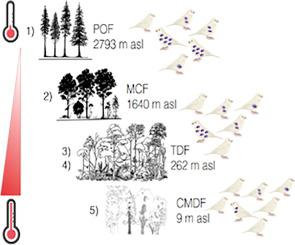International Journal for Parasitology ( IF 3.7 ) Pub Date : 2021-01-14 , DOI: 10.1016/j.ijpara.2020.10.006 Karla Rodríguez-Hernández 1 , Paulina Álvarez-Mendizábal 2 , Leonardo Chapa-Vargas 3 , Federico Escobar 4 , Fernando González-García 1 , Diego Santiago-Alarcon 1

|
The transmission of vector-borne protozoa such as parasites of the Order Haemosporida is dependent on both biotic and abiotic factors such as host life history traits and environmental conditions. This study aimed to identify the variables that determine haemosporidian prevalence, parasitaemia and aggregation within the context of elevation and avian life history traits in Central Veracruz, Mexico. We sampled 607 birds from 88 species; we used microscopy and the mtDNA cytochrome b gene to detect parasites. We found an overall prevalence of 32.3%. Haemosporidian prevalence was 21.6% in tropical sub-deciduous forest (at sea level), 38% in tropical deciduous forest (265 m above sea level (asl)), 19.4% in montane cloud forest (1630 m asl), and 51.7% in pine-oak forest (2790 m asl). The prevalence of each parasite genus was strongly influenced by elevation (a proxy of habitat type). Plasmodium showed the highest prevalence at low elevation. Haemoproteus increased in prevalence with elevation. Leucocytozoon displayed the highest prevalence at the highest elevation (pine-oak forest). Haemoproteus spp. and Leucocytozoon spp. prevalences were higher in open cup than in closed nests. Haemoproteus prevalence and haemosporidian parasitaemia were lower in solitary birds than birds with pairing and gregarious behavior. Haemosporidian aggregation decreased with elevation, yielding the significantly lowest values at the pine-oak forest. Elevation distribution patterns of prevalence for each genus were similar to those previously reported in other geographical areas (e.g., South America, Europe).
中文翻译:

与不同海拔鸟类组合生活史特征相关的血孢子虫流行率、寄生虫血症和聚集
媒介传播的原生动物(例如血孢子虫目寄生虫)的传播取决于生物和非生物因素,例如宿主生活史特征和环境条件。本研究旨在确定在墨西哥韦拉克鲁斯中部海拔和鸟类生活史特征背景下决定血孢子虫流行率、寄生虫血症和聚集的变量。我们从 88 个物种中抽取了 607 只鸟;我们使用显微镜检查和 mtDNA 细胞色素 b 基因来检测寄生虫。我们发现总体患病率为 32.3%。热带亚落叶林(海平面)的血孢子虫流行率为 21.6%,热带落叶林(海拔 265 米(asl))为 38%,山地云雾林(海拔 1630 米)为 19.4%,热带落叶林为 51.7%松橡树林(海拔 2790 米)。疟原虫在低海拔地区的流行率最高。Haemoproteus的流行率随海拔升高而增加。白细胞动物在最高海拔(松橡树林)的流行率最高。嗜血杆菌属 和白细胞动物属。开口杯中的流行率高于封闭巢中。变形杆菌属独居鸟类的流行率和血孢子虫寄生虫血症低于具有配对和群居行为的鸟类。血孢子虫聚集随着海拔的升高而减少,在松橡树林中产生的值显着最低。每个属的流行率海拔分布模式与之前在其他地理区域(例如南美、欧洲)报告的相似。











































 京公网安备 11010802027423号
京公网安备 11010802027423号